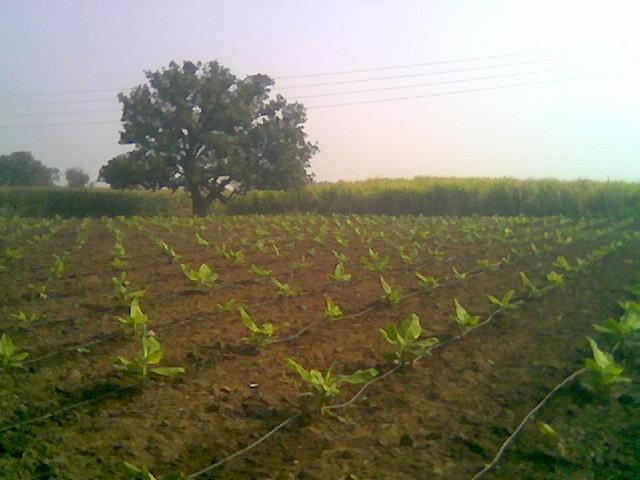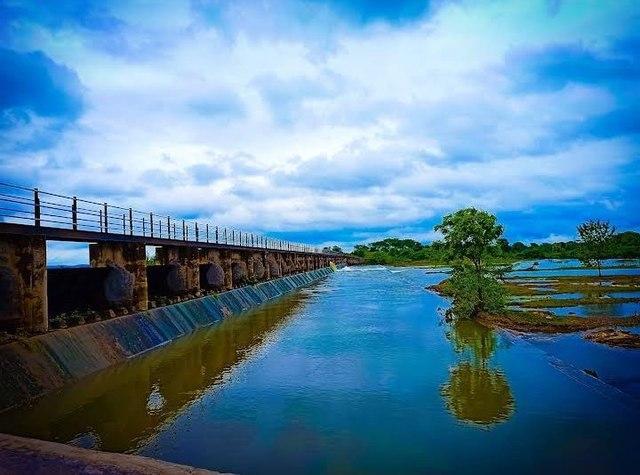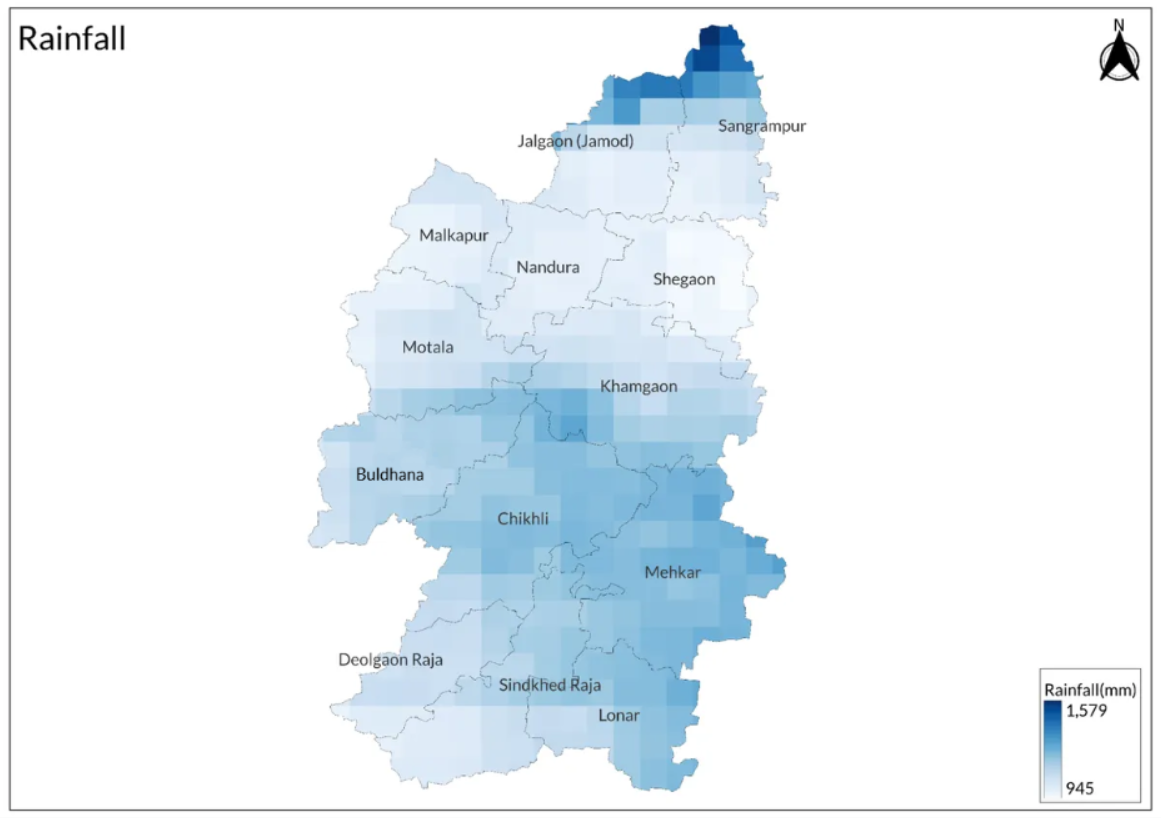Contents
- Crop Cultivation
- Agricultural Communities
- Festivals or Rituals Related to Farming
- Gudi Padwa
- Dussehra
- Types of Farming
- Crop Rotation
- Traditional Agricultural Practices
- Agricultural Implements
- Mot Irrigation
- Use of Technology
- Drones in Farming
- Institutional Infrastructure
- Swatantrya Vir Ganpatrao Ingle College of Agriculture, Jalgaon-Jamod
- Nalganga Project
- Market Structure: APMCs
- List of APMC Markets (as of September 2024)
- Farmers Issues
- Droughts, Unseasonal Rains, and Climate Adaptation Efforts
- Graphs
- Irrigation
- A. No. of Projects
- B. No. of Ponds/Vilage Lakes and Storage Dams
- C. Irrigation Beneficiary Area vs Irrigated Area
- D. Share of Beneficiary Area Irrigated
- E. Tubewells and Pumps Installed In The Year
- F. Irrigation and Water Pumping Facilities
- Cropping Metrics
- A. Share in Total Holdings
- B. Cultivated Area (With Components)
- C. Gross Cropped Area (Irrigated + Unirrigated)
- D. Share of Cropped Area Irrigated
- E. Distribution of Chemical Fertilizers
- Land Use and Credit
- A. Area of Agricultural Land Holdings (With Size Group)
- B. Size Groups' Share in Total Agricultural Land Holdings Area
- C. No. of Agricultural Land Holdings (With Size Group)
- D. Size Groups' Share in Total No. of Agricultural Land Holdings
- E. Agricultural Lending
- F. Agricultural Credit as a share of Total Credit
- Sources
BULDHANA
Agriculture
Last updated on 6 November 2025. Help us improve the information on this page by clicking on suggest edits or writing to us.
The district of Buldhana is believed to be the easternmost district of the drought-prone Vidarbha region of the state. Known for its rich black soil, typical of the Deccan Plateau, its economy primarily depends on agriculture, with Cotton, Soybean, and Jowar being major crops sown.
Crop Cultivation

The district of Buldhana lies entirely in the western part of the Deccan Plateau. The weather is usually Hot, moist, and semi-arid. Some of the major types of soils found are Deep black soil, Medium deep black soil, and shallow black soil.

It benefits from the presence of several rivers, including the Penganga, Nalganga, Purna, Dyanganga, Wagar, and Biswa-Ganga, which contribute to its agricultural suitability. The region supports the cultivation of a variety of Kharif crops, such as green gram, cotton, soybean, black gram, pigeon pea, and sorghum. During the Rabi season, farmers commonly grow wheat, gram (chickpea), and safflower.
In addition to food grains and pulses, the district is also known for its horticultural produce. Fruits such as mangoes, oranges, bananas, mosambi (sweet lime), ber, guava, custard apple, and kagzi lime are grown widely. The region also supports the cultivation of vegetables, including onion, tomato, cauliflower, lady’s finger (okra), brinjal (eggplant), and cabbage.
Agricultural Communities
Agriculture in Buldhana district is closely linked to the livelihoods of several communities. The Kunbis are traditionally regarded as a major cultivating community in the region. The Malis also play a significant role in agriculture, particularly in horticultural activities. The Mahars, while primarily engaged as agricultural laborers, are also known for their involvement in weaving coarse cotton cloth.
The Dhangars, traditionally shepherds, continue to practice animal husbandry alongside farming. The Baris are associated with the cultivation of pan (betel leaf), a specialized agricultural practice. Marathas and Kolis are also engaged in farming across the district. Among the indigenous communities, the Andhs are notable for their agricultural practices, which closely resemble those of the Kunbis. The Andhs are primarily found in the Berar region, of which Buldhana was historically a part.
Festivals or Rituals Related to Farming
Gudi Padwa
In Buldhana district, several traditional festivals are closely associated with agricultural practices. Gudi Padwa, which marks the beginning of the Hindu lunar new year, also signifies the start of the agricultural cycle. On this occasion, farmers symbolically commence fieldwork by striking the soil with a spade, marking the renewal of farming activities.
Dussehra
Dussehra is another festival of particular importance, especially among cotton cultivators. On this day, farmers perform a ritual in which curdled rice is brought to the fields. The land is worshipped as a maternal figure, and the rice is offered in reverence before the cotton-picking process begins.
Types of Farming

Agricultural practices in the Buldhana district are largely dependent on the monsoon. Sowing typically begins with the onset of adequate rainfall, with special significance given to cotton sowing during the Mrug Nakshatra period. Early sowing of cotton is traditionally associated with higher yields. Approximately 30 to 50 mm of rainfall is considered sufficient to commence the sowing of kharif crops, especially cotton.
Major kharif crops grown in the district include cotton, jowar (sorghum), bajra (pearl millet), mug (green gram), udid (black gram), tur (pigeon pea), matki (moth bean), groundnut, chillies, and various vegetables. Among these, jowar is one of the most commonly cultivated crops during the kharif season. Sowing typically begins in June, provided timely rains, with harvesting taking place from September to November. Crops like cotton and chillies are picked in successive rounds between October and December, with intervals of 10 to 15 days between each picking.
The rabi season extends from mid-October to February, with principal crops including wheat, gram (chickpea), safflower, and linseed. Sowing of wheat and gram generally begins in early October, particularly in non-irrigated areas, while sowing in irrigated fields may occur later. Harvesting of these crops typically occurs in March.
Crop Rotation
The system of rotation of crops and the pattern of cropping are practiced here and vary from soil to soil, depending upon irrigation and other facilities available in the district. The cultivators generally grow cotton crops on heavy soils during the first year, jowar during the second year, and during the third year, sometimes it is left fallow in the kharif season, and wheat or gram is grown in the rabi season. Generally, the rotation of crops commonly observed on medium types of soils comprises cotton crops during the first year, jowar during the second year, and groundnut or mug during the third year. Sometimes the heavy and medium types of soils, as well as lighter types of soils, have a fourfold crop rotation.
Another system of crop rotation is followed on heavier types of soil. Cultivators keep the land fallow during the kharif season, prepare it during the rainy season whenever there is a break in rains, and grow the wheat crop in the rabi season. During the second year, the cotton crop is grown on the same soil.
Traditional Agricultural Practices
Agricultural Implements
Traditional agricultural implements in the Buldhana district are largely produced using indigenous materials by local artisans. These tools, many of which have remained unchanged for generations, continue to serve essential functions in local farming practices.
Common hand tools include the khurpi, phavade, kudli, tikas, zadi, kurhad, and sabbal, each used for specific tasks such as digging, weeding, or cutting. These implements are typically crafted from locally available materials and are maintained by village blacksmiths and carpenters.
Among the most important implements is the plow, used for primary tillage. Two main types of ploughs are employed in the region: a light plough drawn by a single pair of bullocks and a heavy plough, characterized by a shorter body and drawn by three or more pairs of bullocks. The traditional wooden plough, locally known as the nangar, is usually made from Babhul (Acacia arabica) wood and comprises four main parts: the main body (khod), beam (dandi), ploughshare (phad), and stilt (rumhane).
The harrow, locally referred to as wakhar or bakhar, is another widely used implement that serves both as a plough and a soil pulverizer. Used to crush clods and prepare the field for sowing, it resembles a large scraper and is made from Babul and Tiwas wood. The harrow consists of five parts: the head, prongs, iron blade (pas), beam (dandi), and stilt (rumhane). The iron blade is attached between the two prongs affixed to the head. Two main varieties are used in the district: the heavy harrow (moghada wakhar), drawn by two pairs of bullocks for hard or weed-infested soils, and a lighter version for regular soil conditions.
For sowing, the seed drill, known as the Tifan, is commonly used. Made from babul wood by local carpenters, it typically includes three coulters, a beam (danda), three bamboo tubes, and a bowl (chale). Several variations of the Tifan exist in the district. The standard three-coulter Tifan is primarily used for sowing kharif jowar. The Argada, which may have three or four coulters, uses bamboo pipes with small bowls (sarate) tied to each coulter using ropes and is suitable for sowing cotton and groundnut. Another type, the Dusa or Kathani Tifan, is a multipurpose drill used for sowing wheat, gram, coriander, mustard, and occasionally kharif crops like cotton.
Threshing implements are minimal and include tools such as the tivar, datale, baskets, chaff-cutters, and blowing fans. The datale, featuring five or six teeth fixed to a small headpiece, is used for stirring and separating grain from husk during threshing. Additionally, a special broom is employed to assist in separating chaff from heaps of grain.
Mot Irrigation
In earlier times, water was lifted from the well for irrigation by a leather bag called a mot. It is the chief contrivance for lifting water from wells. Mot is made of tanned hide by local cobblers. The two ends of the mot are tied by two separate ropes to the yoke. There is a double yoke, about four feet in length. The bullocks yoked to the mot are driven forward and backwards over the ramp. The two ropes (called nada and samdur) pass over the two revolving wheels.
Use of Technology
The use of technology has increased in the past few decades, with more and more farmers taking up modern cultivation techniques such as the use of Tractors, Drips, and other types of modern irrigation techniques, using drones, etc. As a result, many traditional practices have changed over time; the age-old wooden plough has recently been replaced by the iron plough and the old mot by the oil engine in the district. A few improved implements, such as iron ploughs, blowing fans, threshing, and separating appliances, are also being used. In addition to this, there has been an adoption of modern irrigation techniques, increased use of chemical fertilizers, increased use and availability of genetically modified seed varieties, etc. These changes have somewhat changed the agricultural landscape of the district.
Drones in Farming
In September 2023, the Govt of Maharashtra and Marut Drones, in collaboration, introduced Marut’s AG365 drones to farmers of the Buldhana district. Eknath Shinde, the Chief Minister of Maharashtra, interacted with the beneficiaries and encouraged them to spread awareness about the use of drones in farming.
The drone, with its highly reliable safety features like a collision detection and avoidance system and safe return to launch, has already become a point of attraction for farmers, being the first and only drone in Buldhana under the SMAM (Sub-mission On Agriculture Mechanisation) scheme.
Institutional Infrastructure
As per NABARD’s Potential Linked Credit Plan for Buldhana (2022-23), the agricultural infrastructure in the Buldhana district appears to remain limited in several respects. The district has 13 Agricultural Produce Market Committees (APMCs) facilitating trade and price regulation, and 482 godowns for storage. There are 5 soil testing laboratories, 12 plantation nurseries, and around 1600 input outlets providing fertilizers, seeds, and pesticides. The presence of 3304 farmers’ clubs reflects the efforts at building grassroots-level networks for knowledge sharing and collective action. Agricultural extension services are supported by two Krishi Vigyan Kendras (KVKs) located within the district.
In terms of financial infrastructure, Buldhana has 12 commercial banks, 1 regional rural bank, the District Central Cooperative Bank, and 567 Primary Agricultural Credit Societies (PACS).
Swatantrya Vir Ganpatrao Ingle College of Agriculture, Jalgaon-Jamod
The Swatantrya Vir Ganpatrao Ingle College of Agriculture in Jalgaon Jamod was established in 2003 under the aegis of the Satpuda Education Society, which was founded in 1991 to provide educational opportunities to students from farming and economically disadvantaged backgrounds. The college is affiliated with Dr. Panjabrao Deshmukh Krishi Vidyapeeth, Akola.
It offers undergraduate and postgraduate programs in fields such as Agronomy, Botany, Agricultural Economics, Entomology, Plant Pathology, Soil Science and Agricultural Chemistry, and Animal Husbandry and Dairy Science. The institution contributes to higher education in agriculture in the region and supports skill development among rural youth.
Nalganga Project
The Nalganga dam is a medium irrigation project. It is constructed across the river Nalganga near Sangled Budruk in Malkapur tehsil of Buldhana district. The construction of this project was taken in hand in 1957 and completed in 1967-68. The total estimated cost of the project was Rs. 266.79 lakhs. The project is composed of an earthen dam with a height of 29.9 meters. The length of the composite dam is 2,516 meters, with a gated spillway of 167.75 meters and a canal system of 31 km with a distributary branch of 47 km. The main crops irrigated under this project are cotton, wheat, groundnut, vegetables, pulses, sugarcane, etc. The project commands an area of 39,000 acres.

Market Structure: APMCs
There are APMCs at Buldhana City, Chikhali, Deulgaon Raja, Jalgaon Jamod, Khamgaon, Lonar, Malkapur, Mehekar, Motala, Nandura, Sangrampur, Shegaon, and Sindkhed Raja. The Shegaon and Malkapur APMCs are the oldest ones in the district. Cotton, Wheat (husked), pigeon pea, Jowar, maize, soybean, etc., are important commodities that are sold at these markets.
List of APMC Markets (as of September 2024)
|
Sr. No |
Name |
Est. Year |
Chairman |
No. of Godowns |
|
1. |
Buldhana |
1999 |
Jalindhar Ashruba Budhwat |
3 |
|
2. |
Chikhali |
1917 |
Santosh Wankhade |
6 |
|
3. |
Deulgaon Raja |
1931 |
Samadhan Singhane |
69 |
|
4. |
Jalgaon Jamod |
1903 |
Prasenjeet Patil |
NA |
|
5. |
Khamgaon |
1993 |
Subhash Laxmanrav Pesode |
8 |
|
6. |
Lonar |
1968 |
Baliram Barkuji Mapari |
3 |
|
7. |
Malkapur |
1900 |
Shivchandra Tejrao Tayde |
4 |
|
8. |
Mehekar |
1928 |
Madhavrao Ganpatrao Jadhav |
7 |
|
9. |
Motala |
1986 |
Tejrao Dinkar Wagh |
3 |
|
10. |
Nandura |
1916 |
Bhagvan Narayan Dhande |
3 |
|
11. |
Sangrampur |
1976 |
Gajanan Shankarao Dane |
5 |
|
12. |
Shegaon |
1900 |
Gopalrao Wamanrao Mirage |
4 |
|
13. |
Sindhkhed Raja |
1999 |
Anil Murhari Tupkar |
3 |
Farmers Issues
Farmers in Buldhana district face a range of persistent challenges, including recurring droughts, unseasonal rainfall, infrastructural deficits, debt burdens, low market prices, high input costs, and inadequate storage facilities. These issues collectively contribute to agricultural distress and financial insecurity. A significant consequence of this agrarian crisis has been the prevalence of farmer suicides. According to Arya (2019), between 2001 and 2019, a total of 2,681 farmer suicides were reported in the district, with nearly 47% attributed to recurrent droughts and indebtedness.
Droughts, Unseasonal Rains, and Climate Adaptation Efforts
The district has historically experienced prolonged droughts, famines, and water scarcity, severely impacting agriculture and the local economy. In addition to drought, unseasonal rains and hailstorms have caused significant losses to crops like Tur (Pigeon Pea), Cotton, and various horticultural produce. In 2023, hailstorms and unexpected rainfall damaged 99,381 hectares of farmland across northern Maharashtra, with Buldhana and Nashik among the worst-affected regions.

To mitigate these impacts, the Government of Maharashtra launched the Project on Climate Resilient Agriculture (PoCRA) in 2018, also known as Nanaji Deshmukh Krushi Sanjivani Prakalp. This initiative seeks to strengthen farmers' capacity to cope with climate variability by promoting improved irrigation systems, constructing water retention structures such as ponds and wells, and encouraging climate-resilient farming practices. PoCRA has been implemented across 16 of Maharashtra’s 36 districts and is regarded as one of India’s largest climate adaptation programs in agriculture.
Despite its scope, the distribution of PoCRA funding has been uneven. Reports suggest that over 60% of the financial assistance has been concentrated in just three districts, while Buldhana received only about 5.44% of the total funds. This imbalance has limited the number of farmers who can access climate adaptation resources, leaving many vulnerable to the ongoing threats of droughts and extreme weather.
Graphs
Irrigation
Cropping Metrics
Land Use and Credit
Sources
About the Maharashtra State Agricultural Marketing Boardhttps://www.msamb.com/ApmcDetail/Profile#pag…
Govt. Of Maharashtra. 1910 & 1976. District Gazetteers,Buldhana District.Gazetteers Dept. Mumbai.
ICAR. 2017. MAHARASHTRA Agriculture Contingency Plan for District: BULDHANA.ICAR - CRIDA - NICRA.https://krishi.icar.gov.in/jspui/bitstream/1…
Maharashtra chief-minister introduces Marut-drones to farmers of Buldhanahttps://www.en.krishakjagat.org/mechanizatio…
NABARD. 2022-23. Potential Linked Credit Plan for Buldhana.https://www.nabard.org/auth/writereaddata/te…
Priyanka Kakodkar. 2023. Maharashtra crops on almost 1 lakh hectares damaged by unseasonal rain. Times of India, Mumbaihttp://timesofindia.indiatimes.com/articlesh…
Satpuda Education Societyhttps://agri.satpudaeducation.in/
Shishir Arya. 2019. Buldhana is emerging as the new farm suicide capital of the state. The Times of India. Nagpurhttp://timesofindia.indiatimes.com/articlesh…
Vineet Kumar. 2023. Maharashtra’s project funds for climate-resilient agriculture has gone to just a few districts and types of interventions.Down to Earth.https://www.downtoearth.org.in/agriculture/m…
Last updated on 6 November 2025. Help us improve the information on this page by clicking on suggest edits or writing to us.